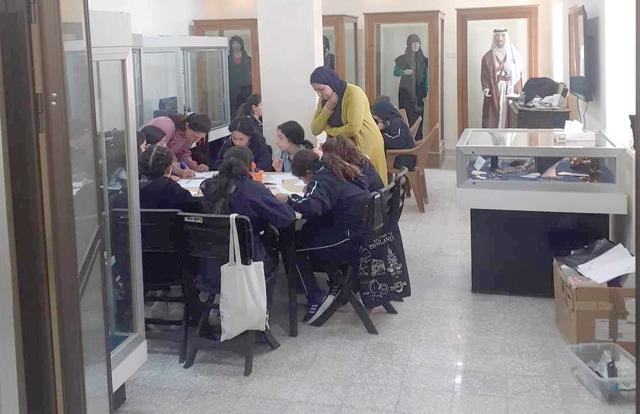You are here
How ‘pre-conceived notions’ are hindering access to heritage
By Saeb Rawashdeh - Jun 26,2019 - Last updated at Jun 26,2019

Children enjoying an archaeological site in Jerash (Photo courtesy of Arwa Badran)
AMMAN — “Collecting artefacts is a part of our nature, it is after all a human trait”, said Jordanian archaeologist and museum specialist Arwa Badran.
However, more needs to be done to bridge the gap between scholars and the general public, and this work is vital to the promotion of Jordanian cultural heritage, Badran added.
“In our region, systematic collecting has been traced as far back as Nebuchadnezzar II in 6th century BC Mesopotamia. For the geographical area of Jordan, however, the earliest reference to private collecting is... found in private houses in Madaba in the late 19th century/early 20th century,” said Badran, adding that the state ownership of antiquities took effect gradually after the introduction of the Antiquaries Law in the 1920s, which stipulated that all of the antiquities in Jordan — above or under the ground — belonged to the state.
“The first thing is for us; the heritage professionals, to change our pre-held perception of the Jordanian community, which is commonly expressed as ‘they [the community] are ignorant; they [the community] do not understand or appreciate their heritage’. The Jordanian community does value its heritage, although this value is probably different from that of a professional,” Badran told The Jordan Times in a recent interview.
One of the problems, according to the scholar, is a “rigid definition” of value-based heritage centred on foreign tourists.
“Tourists are seen as civilised and educated, therefore they are able to value heritage ‘as prescribed’. They are therefore more welcome to enjoy the heritage of Jordan than its own community. We need to start trusting our people, rather than building fences around heritage sites.”
Trust-building takes time and will require creating channels of communication and understanding in order to really unravel what heritage means for Jordanian society, the archaeologist stressed.
“If we are going to tell people why heritage is important, we need to start with what is significant to them first and build gradually on that to further expand on the various values of heritage.”
Another crucial aspect is working with society to introduce heritage studies at a younger age, she added.
Badran is critical of the national curriculum: “While human occupation in our region spans over 1.5 million years, the national curriculum covers just under a thousand years [mostly the Nabatean, Umayyad periods and the 20th century]. This means that our education system excludes more than 99 per cent of the past in Jordan.”
Moreover, whenever archaeological heritage is presented in textbooks, it is highlighted mainly as an economic resource within tourism, she elaborated, noting that there is a need for closer collaboration between the sectors of heritage and education.
According to Badran, who is currently based at Durham University in the UK, a common practice that dominated 20th century archaeological work in Jordan was excavating sites using cheap local labour to assist in earth removal, and then studying and storing artefacts; or at times placing them on display in museums and publishing articles to disseminate findings.
“Today, archaeologists are more concerned with preserving, interpreting and managing sites that have already been excavated for the public to visit, enjoy and learn. Basically, what we refer to as sustainable tourism. This is accompanied with a growing awareness for the need to involve the local community in managing their heritage through consultation, education, training and employment,” Badran emphasised.
The scholar pointed to a few successful initiatives that have emerged over the past 20 years, aiming to increase school children’s awareness of their heritage, and train and employ local skilled labour to undertake restoration work, such as the Umm Al Jimal Project; or at Sela for Vocational Training and Protection of Cultural Heritage, a community-led training company in Petra and USAID’s Sustainable Cultural Heritage Through Engagement of Local Communities Project.
However, local museums are beginning to catch up and rethink their roles within society and how to best develop their practices and services to meet the demands of today, she said.
“A new wave of museums, founded since 2000, are focused on serving public interests and needs, such as the Jordan Museum, the Children’s Museum, the Royal Automobile Museum and the Royal Tank Museum,” Badran underscored.
“This year, the Newton-Khalidi Fund, through the Arts and Humanities Research Council in the United Kingdom, funded 10 projects towards sustainable cultural heritage projects in Jordan,” she added, noting that one of those projects, titled: “Learning from Multicultural Amman: Engaging Jordan’s Youth” [www.dur.ac.uk/archaeology/research/impact/jordan] is working on raising museum standards and finding ways to establish partnerships with schools and universities to better engage youth in learning about their past.
Related Articles
AMMAN — In March 2019, a group of scholars and local decision-makers launched a project to engage students with Jordanian museums and educat
AMMAN — Traditionally, archaeological teams would go to the site, excavate, collect artefacts, analyse them and prepare reports that would b
AMMAN — Extensive archaeological sites, including the world-famous mosaic in Madaba, have long made central Jordan a source of fascination a



















